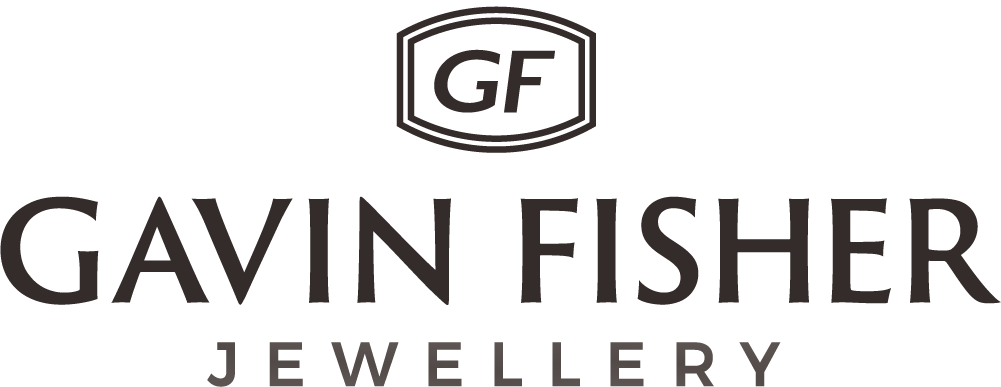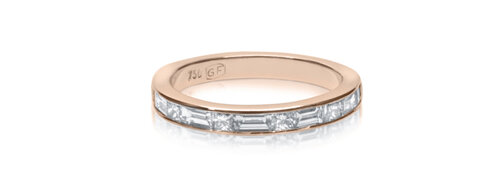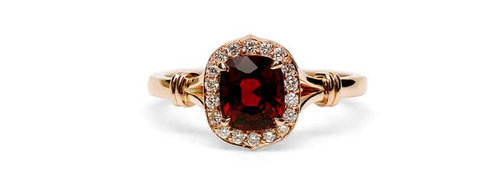Diamond 4Cs
GIA’s 4C Diamond Grading
The 4Cs of diamonds is four individual grading scales for determining a diamond’s quality, and therefore a diamond’s price. The centre stone diamond’s cost is likely the biggest factor in a custom made diamond ring, so choosing the right one needs careful consideration. In principle, the diamond 4Cs chart an individual diamond’s rarity against all the other natural diamonds in the world. As you would expect, the rarer the diamond is—due to its larger size, colour (or rather lack of colour), minimal flaws and cut well to refract light—it will fetch much higher prices as there just aren’t that many diamonds like it in the world.
Having a system like the diamond 4C chart helps understand a diamond’s overall quality. Basic knowledge of the 4Cs will not only unlock the mystery of a diamond’s brilliance, it will help you understand a diamond’s value and price. Once you know some of the basics you will become fascinated by this alluring gemstone, prized above all others.
I personally use the Gemological Institute of America’s (GIA) diamond 4Cs chart as it is the most widely accepted diamond grading system used around the world. This diamond quality chart grades each diamond against these four distinct factors:.
- Diamond Carat
- Diamond Colour
- Diamond Clarity
- Diamond Cut
Read on and I will explain the diamond 4C factors in more detail. When you are ready, come in for a personal jewellery consultation where I will explain the 4Cs of diamonds in more detail, and guide you on the right selection for your handmade custom diamond engagement ring.
I work with the finest diamond suppliers to personally source exquisite, natural conflict free diamonds from around the world.
1. Diamond Carat
Diamond carat refers to a diamond’s weight, and it is a big factor in a diamond’s price. As we already know, diamond grading is a measure of rarity and therefore value, so higher carat diamonds are fewer and further between. As you can imagine, it is much rarer to find a large 5 carat flawless diamond than it is to find a smaller 1 carat diamond. You have probably heard stories of the Crown Jewels and other famous diamonds that are massive—their exorbitant value is due to the fact there are no others like it in the world. 1 carat of diamond is equal to 0.2 grams.
While you should not be solely focused on a diamond’s carat size, it is likely the first thing you will evaluate when selecting a stone. And, it’s likely the first question you will be asked about by friends and family when you show off your ring.
DIAMOND CARAT SIZE
Carat sizes are generally as follows, and see the diamond carat scale chart for a better sense of scale. Displayed size is relative only to your screen.
-
½ carat diamond = 5.0mm dia.
-
1 carat diamond = 6.5mm dia.
-
2 carat diamond = 8.0mm dia.
-
3 carat diamond = 9.3mm dia.
-
4 carat diamond = 10.4mm dia.
-
5 carat diamond = 11.0mm dia.
DIAMOND PRICE PER CARAT
A diamond’s carat weight is a big factor in a diamond’s price. Generally speaking, the higher the carat weight, the more expensive the diamond. Whole sizes drive a higher price, and choosing a diamond that is, say, a round 2 carat number will be much more expensive than a diamond of equal quality but that is slightly under at 1.95 carats. Yet, diamond carat weight is only one factor in a diamond’s price: Two diamonds of equal carat weight can have very different qualities and value when the other diamond grading factors are also considered.
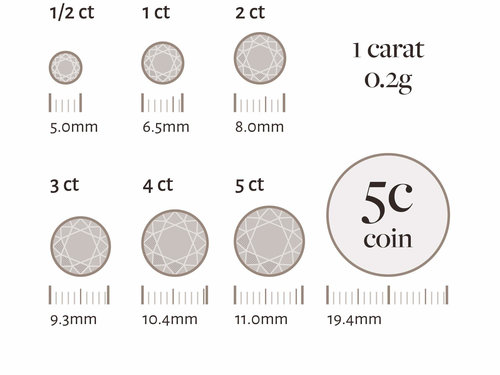
Diamond carat size is one factor in diamond price. It is a measure of the weight of a diamond, but commonly it is used as a default reference for a diamond’s visual size.
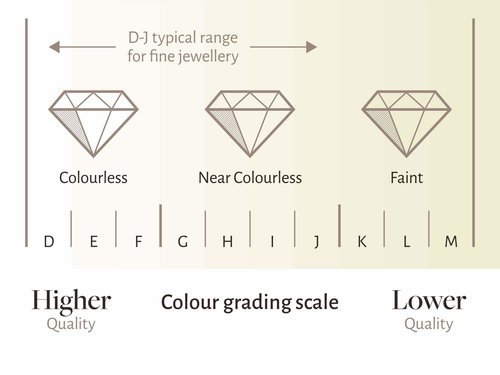
The best diamond colour grade is ‘D’, and the colour chart ranges all the way to ‘Z’ on the yellow end of the diamond colour spectrum. Most fine jewellery is between ‘D’ and ‘J’ grades.
2. Diamond Colour
The best diamond colour grade actually refers to the absence of colour. The less colour in a normal diamond, the more desirable and valuable it is. Some of these differences are not visible to the naked eye, but directly impact the overall quality and price of the diamond. Diamond chart colours range from completely colourless which are the rarest and highest priced, to tinges of yellow and brown which dull the stone and are more common and therefore lower in value.
DIAMOND COLOUR GRADE
The highest grade for diamond colour—which is the purest, whitest, colourless crystal—is ‘D’ (when the GIA created their new diamond colour grade chart they were updating from an old ABC system, and not to cause any confusion they began their grades after that outdated system). The scale runs from completely colourless at ‘D’ all the way to ‘Z’ at the yellow end.
FANCY COLOUR DIAMONDS
Diamonds come in all colours! While colourless diamonds are by far the most popular and sort after, there is a whole spectrum of diamond colours to explore. In fact, I made my wife’s ring in a stunning yellow diamond from South Africa, surrounded by colourless diamonds: you can see it on my about page. Don’t be afraid to step outside the box and think differently for your custom made diamond engagement ring. This is the true benefit of choosing a handmade ring: you can design your very own jewellery creation and break the norms we have come to expect.
3. Diamond Clarity
Diamond clarity measures the amount, size and placement of internal ‘inclusions,’ and external ‘blemishes.’ Think of these as small imperfections inside the diamond crystal itself, or nicks on the outside of the stone. Most diamonds have different amounts and types of natural inclusions within the stone. It’s hard to find true flawless diamonds, and they are incredibly expensive. Of all the factors in choosing the right stone it is perfectly fine to accept a mid-range clarity grade of diamond.
DIAMOND CLARITY CHART
The diamond clarity scale runs from ‘Flawless’ with virtually no imperfections, to ‘Included’ which contain a significant number of imperfections. The easiest way to explain diamond clarity ratings is to list them out from best to worst at 10x magnification:
-
FL: Flawless (No inclusions or blemishes, even at 10x magnification)
-
IF: Internally flawless
-
VVS1 – VVS2: Very very slightly included
-
VS1 – VS2: Very slightly included
-
SI1 – SI2: Slightly included
-
I1 – I2 – I3: Included (Inclusions and blemishes visible to the naked eye)
THE BEST DIAMOND CLARITY TO BUY
A true flawless diamond is incredibly rare, and most diamonds have some inclusions. While clarity can impact a diamond’s price, the best value diamond clarity for an individual stone might be lower, giving you a much better price. As the diamond clarity grading is performed at 10x magnification, we can make an individual assessment on a specific diamond to determine if clarity will have any impact on your diamond engagement ring’s beauty. In fact not all inclusions are negative: natural clarity imperfections is still the best way to determine a natural diamond from a synthetic imitation diamond.
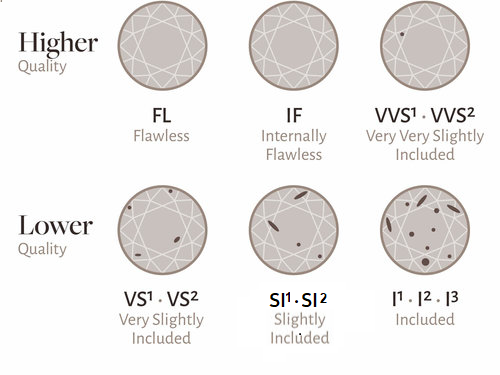
One of the more confusing GIA scales, diamond clarity grades simply chart imperfections in an individual stone’s interior and exterior.
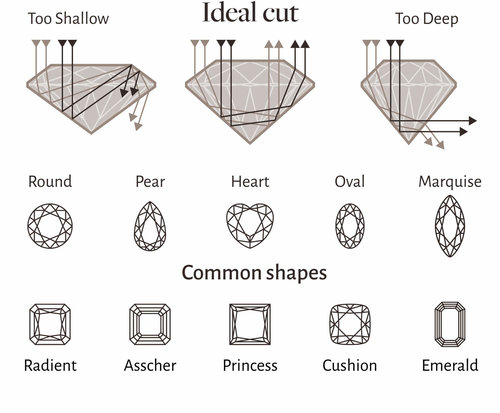
A diamond’s cut can have an overwhelming impact on the visual impact of diamond, regardless of the diamond shape. The best cuts refract light and show off the qualities of the diamond.
4. Diamond Cut
Diamond cut is a measure of how light performs refracting through a diamond. The difference between two stones that have the same grading, but being cut differently—whether it be symmetry, proportions or polish—can make the world of difference in how that diamond performs. An ideal cut diamond achieving an ‘Excellent’ grade refracts light in such a way that makes that diamond sparkle.
DIAMOND CUT GRADING CHART
GIA diamond cut grades range from ‘Excellent’ to ‘Poor.’ A diamond’s cut grade is judged by the proportion and arrangement of its facets and the quality of workmanship. The amount of brilliance, sparkle and fire in a diamond is determined by a diamond’s cut, and are the measures GIA diamond cut grade scales are based on.
HOW ARE DIAMONDS CUT?
Did you know that how diamonds are cut has always been done by hand? It continues to be a true art form. Each rough diamond crystal is assessed and judged on how to make the most out of it, and what shape it will end up being cut into. Then, it is mapped, cut into the basic shape and then each individual facet cut and polished by hand.
TYPES OF DIAMOND CUTS
There are many different diamond cuts. While diamond cut does not refer to a diamond’s shape, it is an all important factor in choosing any diamond. Here are the most common shapes:
-
Round Brilliant Cut Diamond
-
Princess Cut Diamond
-
Cushion Cut Diamond
-
Oval Cut Diamond
-
Emerald Cut Diamond
-
Asscher Cut Diamond
-
Radiant Cut Diamond
-
Marquise Cut Diamond
-
Pear Shaped or Teardrop Diamond
-
Heart-Shaped Diamond
What are the 5Cs of Diamonds?
The 5Cs of diamonds goes beyond the typical 4Cs of diamonds—colour, carat, clarity and cut—to consider a diamond’s make. While the 4Cs of diamonds are universal trade guidelines to judge an individual diamond’s rarity, and therefore that diamond’s price, the five Cs considers the appreciation of the overall diamond’s proportions, facets, lustre and scintillation anyone can see with the naked eye. Make is essentially the beauty the diamond emanates and what makes the diamond remarkable and unique.
Most jewellers focus solely on the 4Cs, simply because it is the basic knowledge most customers gather and understand. There will always be one diamond that is more desirable than the others due to its make… this is the diamond that we are looking for!
Pink Diamonds, Sapphires, Emeralds & Precious Gemstones
Coloured diamonds and gemstones make fascinating custom engagement rings, eternity rings and handmade fine jewellery. Coloured diamonds and gemstones work equally well as the centre stone in a simple setting, or as accent gemstones in your ring or piece. Mixing royal Ceylon blue sapphires and diamonds in platinum settings has been increasing in popularity. Or why not try something more unique such as green emeralds with yellow gold, or even red rubies with white and rose gold? And there exists such a wide variety of semi-precious gemstones to explore such as tourmaline, topaz and opals. Our imagination is the limit.
In times gone by it was actually more traditional to make an engagement ring with sapphire, ruby or emerald centre stones. It is only in more recent ages that clear diamond engagement rings have become the most prized and dominantly given style.
